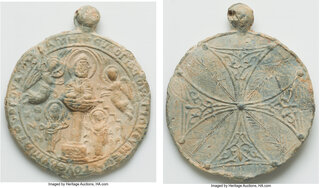| Heritage World Coin Auctions > Showcase Auction 61357 | Auction date: 14 January 2024 |
| Lot number: 22066 Price realized: 420 USD (Approx. 384 EUR) Note: Prices do not include buyer's fees. | Show similar lots on CoinArchives Find similar lots in upcoming auctions on |
| Lot description: Ancients Anonymous. Ca. 10th century AD. Lead "eulogia" medallion (52mm, 30.16 gm). XF. "Eulogia" of St. Symeon Stylites the Younger. +EVΛOΓIA TOV AΓIOV CEIMONOC TOV ΘAVMATOVPΓOV (Blessing of Saint Symeon the Miracle Worker), nimbate, half-length bust of St. Symeon the Younger on a column, wearing monastic hood, holding book of Gospels; flanked by two nimbate flying angels facing center, with Konon (Symeon's disciple, on left), nimbate, standing right, and St. Martha (Symeon's mother, on right), nimbate, standing left, both with their hands raised in gesture of supplication, K/O/N/O/N in left field, Θ / M-A/P-ΘA (Saint Martha) in right field / Large, elaborately decorated cross; leaf in each angle. Cf. Gary Vikan: Art, Medicine, and Magic in Early Byzantium, Dumbarton Oaks Papers 38 (1984), p. 65-86, fig. 7. Byzantine eulogia tokens, also known as eulogiae or blessings, were a distinctive aspect of Byzantine religious and cultural life, primarily during the Middle Ages. These tokens were small, often coin-like objects made from various materials such as lead, bronze, or even precious metals. They were given to pilgrims visiting holy sites, monasteries, or churches as a form of blessing and as a memento of their pilgrimage. The imagery on these tokens was richly symbolic, often featuring religious icons, saints, Christ, the Virgin Mary, or other holy figures and scenes. They served not only as tangible symbols of the pilgrim's journey and devotion but also as amulets believed to offer protection and blessings. Saint Simeon the Younger, also known as Simeon Stylites the Younger, was an ascetic saint who followed in the footsteps of the famous St. Symeon the Stylite. Living in the 6th century AD, he too chose the life of a stylite, spending a significant portion of his life on top of a pillar as a demonstration of his devotion and asceticism. His pillar was located on the slopes of the Wonderful Mountain near Antioch. Saint Simeon the Younger was known for his piety, his endurance, and his ability to inspire and attract pilgrims who sought his counsel and blessings. When Martha's parents betrothed her to a young man from Edessa named John, she considered leaving home. However, John the Baptist is said to have appeared to her and advised her to do as her parents had arranged and marry the man to whom they had betrothed her. She complied and the bore Simeon Stylites. After her death, she was canonized and Saint Martha is said to have appeared to various people in order to heal and inspire hope. She is venerated in the Eastern Orthodox Church on July 4 and in the Catholic Church on July 5. Konon, the disciple of Saint Simeon the Younger, is noted for his close association and dedication to his teacher. As a disciple, Konon would have been integral in assisting Saint Simeon the Younger with his needs while he was atop the pillar and would have played a key role in disseminating his teachings and wisdom to the pilgrims and followers. The relationship between a disciple and a spiritual teacher like Saint Simeon the Younger is a vital part of Christian monastic and ascetic traditions, emphasizing the importance of mentorship and spiritual guidance. https://coins.ha.com/itm/ancients/byzantine/ancients-anonymous-ca-10th-century-ad-lead-eulogia-medallion-52mm-3016-gm-xf/a/61357-22066.s?type=DA-DMC-CoinArchives-WorldCoins-61357-01142024 HID02906262019 © 2023 Heritage Auctions | All Rights Reserved |  |



